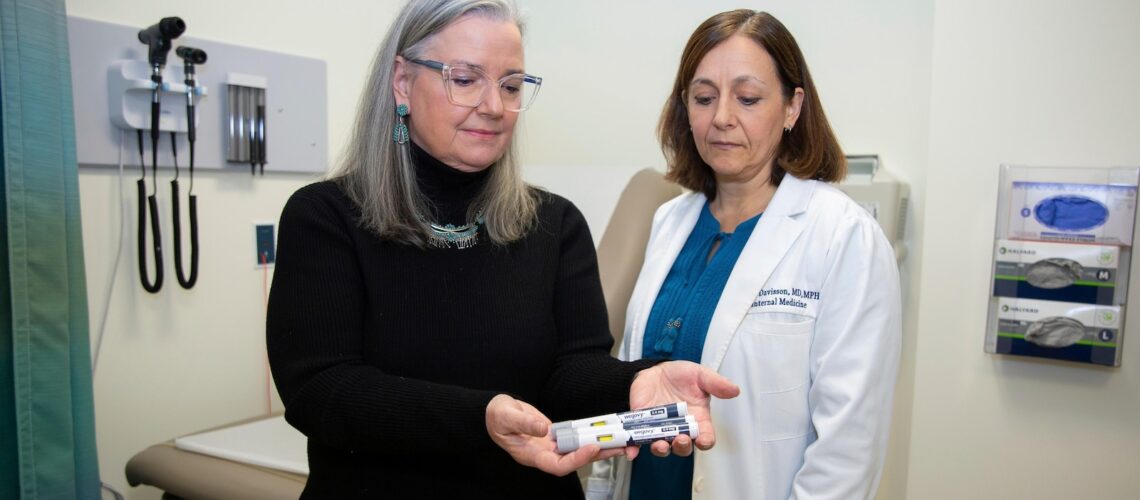West Virginia patients left in limbo over changing insurance coverage of obesity meds
January 2, 2025

- Court Rules on Insurer Reimbursement for Uncovered Loss Recovery
- China EV insurance registrations for week ending Dec 15: Nio 4,400, Tesla 18,500, Xiaomi 5,800, BYD 97,800
- Best Cheap Pet Insurance Of 2025
- Letter: The inhumanity of health insurance: A call for change
- How Luigi Mangione’s Notebook Helped Prosecutors
CHARLESTON, W.Va. — Lory Osborn says the Wegovy she was prescribed 15 months ago did more than help her lose 75 pounds — over a quarter of her body weight. The administrative assistant at West Virginia University said she feels healthier at 62 than she has since graduating high school.
Bạn đang xem: West Virginia patients left in limbo over changing insurance coverage of obesity meds
But lately, she’s been having panic attacks because she fears running out of medication. Citing a gross cost of $1.4 million a month, West Virginia abruptly announced in March it would indefinitely pause a pilot program covering weight loss drugs for 1,000 public employees, leaving patients like her scrambling. West Virginia’s Public Employee Insurance Agency (PEIA) will continue covering the popular and expensive GLP-1 drugs to treat Type 2 diabetes.
Other state and private insurers have adopted similar stances for the drugs, which can cost patients more than $1,000 monthly out-of-pocket. In 2024, Blue Cross Blue Shield of Michigan, the state’s largest nonprofit insurer, and North Carolina’s state employee public insurance agency stopped covering the drugs for weight loss, saying the cost increased premiums for all customers.
The dilemma comes amid a similar debate at the federal level. President Joe Biden unveiled a plan in November to cover the drugs for millions of weight loss patients on Medicaid and Medicare, though the measure could face opposition from President-elect Donald Trump’s administration. Robert F. Kennedy Jr., Trump’s nominee for Health and Human Services Secretary, has criticized Ozempic — a GLP-1 used to treat diabetes.
Proponents say long-term savings could outweigh the cost — especially in West Virginia, which has the nation’s highest rates of obesity and diabetes. Obesity increases their risk for conditions such as heart disease, cancer and high blood pressure. About half of West Virginians rely on Medicare or Medicaid for insurance.
Osborn said it makes no sense for West Virginia to invest the money in the pilot only for patients to come off it and lose their progress. Osborn usually takes her injections once weekly, but said she started waiting 10 or 12 days to make her final three-month supply last.
“It is so cruel,” said Osborn, who took her last PEIA-covered dose of Wegovy weeks ago. “We are suffering mentally just from the thought of going back.”
West Virginia’s residents are among the poorest in the U.S. and the state is home to rural food deserts where it can be hard to find any grocery stores, never mind finding one with a variety of nutritional food options.
Outgoing West Virginia Gov. Jim Justice — who has lost between 30 and 50 pounds while taking Ozempic — said after Biden’s announcement that he would “be a proponent of trying to do everything we can to be able to expand these drugs to everybody.”
“There’s a real argument that at the end of the day, we end up saving that money,” said Justice, who was elected to the U.S. Senate in November. About 25% of Americans have a health insurance plan that covers these weight loss drugs, according to the AXIACI Obesity Coverage Nexus, a database produced by the Leverage consulting firm.
The vast majority of coverage of the drugs is provided by government health plans, largely state Medicaid plans, according to Leverage. All state Medicaid programs cover the drugs for Type 2 diabetes, but only 14 provide some form of coverage to treat obesity. Medicare plans cover the drugs for weight loss if they are prescribed to a person at risk for stroke or heart disease.
Dr. Laura Davisson, medical weight management director at West Virginia University, said losing coverage for medications is a “nightmare” for patients. This year, Davisson’s office saw over 1,000 GLP-1 patients — many of whom have made extra appointments or joined support groups with her staff to discuss options when they learned of the coverage changes.
“We’re the state with the number one rate of obesity, and I’ve just lost all access to my most powerful tool for treating obesity medically with almost every one of my payers,” she said. “How does that make sense?”
The length of time she sees patients take the drugs varies, but some may have to take it indefinitely to suppress food cravings. She said the state employee pilot program took a responsible approach by requiring that patients be prescribed the medications through obesity specialists, giving them counseling on diet, exercise and side effect management.
“They already invested millions of dollars in these people,” she said. “It’s financially wasteful to throw it away, have these people regain their weight, get their health problems back, and we don’t actually get to see the full potential of this pilot project.”
Dr. Bisher Mustafa of the Marshall Health Obesity Clinic in Huntington said there’s a certain irony to waiting “until people have diabetes to start the medication.”
“The idea is to try to prevent diabetes from happening from the beginning,” he said.
Xem thêm : Concord Monitor – Opinion: Changing the conversation around insurance
PEIA Director Brian Cunningham said GLP-1s, which the state began offering for weight loss in 2019, cost the program around $53 million last fiscal year — about 20% of what PEIA spends on drugs.
The cost of the GLP-1s was cited as a reason for 14% premium hikes for state employees, as well as a 16% increase for county employees and a 12% bump in costs for retirees. Increases will go into effect in July, according to the insurance agency, which covers 150,000 government workers, 56,000 retirees and their dependents.
That’s frustrated some PEIA members who feel they are unfairly shouldering the cost burden for a medication they don’t use. Ashley Peggs, a Kanawha County teacher who doesn’t use GLP-1 drugs, said her heart sank when she saw how much the plan was spending on the medicines during a public hearing about the proposed premium increases.
She said the agency had just denied coverage for a spinal procedure for a condition threatening her ability to walk.
“So somebody else being skinny is more important than the fact that I literally may not be able to continue teaching until I retire without a wheelchair?” said Peggs, 35, at the public hearing.
Some taking the drugs for diabetes — like the vast majority of state employees on GLP-1s — expressed frustration that they haven’t even been able to access Ozempic consistently because of shortages.
“What’s going to be cheaper: pay for that medication or for me to lose a leg to gangrene like my grandmother did?” said Michael Kimball, 42, who takes the drug for diabetes. “Year after year, the burden is put on the back of the working man and we’re getting a little tired of it.”
Osborn described Wegovy as a breakthrough recommended by her provider after she’d tried for years to lose weight any way she could. She’s also been able to halve the amount of rheumatoid arthritis medication she takes and she’s seen back pain and her sciatica almost eradicated.
She said dropping coverage for obesity patients feels like “weight-based discrimination” because other chronic diseases qualify. Osborn said she’ll try purchasing versions of the medications that aren’t approved by the FDA through compounding pharmacies. Doing so will increase her cost to around $300 per month. PEIA had provided her with a three-month supply for $50.
“I think that they need to realize that obesity is a disease — it’s not a willpower, gutting-it-out choice,” she said. “It is a disease that you suffer from just like any other disease that you cannot prevent.”
Nguồn: https://propertytax.pics
Danh mục: News
